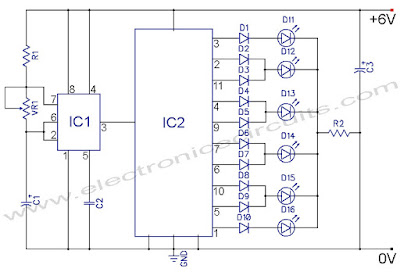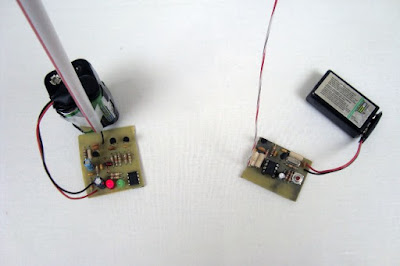LED Knight Rider Using 4017 and 555 IC's
LED Knight Rider Using 4017 and 555 IC's
In this 4017 Knight Rider circuit, the 555 is wired as an oscillator. It can be adjusted to give the desired speed for the display. The output of the 555 is directly connected to the input of a Johnson Counter (CD 4017).
The input of the counter is called the CLOCK line. The 10 outputs become active, one at a time, on the rising edge of the waveform from the 555. Each output can deliver about 20mA but a LED should not be connected to the output without a current-limiting resistor (220Ω in the circuit above).
The first 6 outputs of the chip are connected directly to the 6 LEDs and these “move” across the display. The next 4 outputs move the effect in the opposite direction and the cycle repeats. The animation above shows how the effect appears on the display.
Using six LEDs, the display can be placed in the front of a model car to give a very realistic effect.
The outputs can be taken to driver transistors to produce a larger version of the display.
In this 4017 Knight Rider circuit, the 555 is wired as an oscillator. It can be adjusted to give the desired speed for the display. The output of the 555 is directly connected to the input of a Johnson Counter (CD 4017).
| PARTS LIST | |
| R1 | 22kΩ |
| R2 | 220Ω |
| VR1 | 50kΩ PRESET |
| C1 | 1µF 16V |
| C2 | 0.01µF (103) |
| C3 | 10µF 16V |
| D1 – D10 | 1N4148 |
| D11 – D16 | LED |
| IC1 | NE555 |
| IC2 | CD4017 |
The input of the counter is called the CLOCK line. The 10 outputs become active, one at a time, on the rising edge of the waveform from the 555. Each output can deliver about 20mA but a LED should not be connected to the output without a current-limiting resistor (220Ω in the circuit above).
|
CD4017
|
NE555
|
The first 6 outputs of the chip are connected directly to the 6 LEDs and these “move” across the display. The next 4 outputs move the effect in the opposite direction and the cycle repeats. The animation above shows how the effect appears on the display.
Using six LEDs, the display can be placed in the front of a model car to give a very realistic effect.
The outputs can be taken to driver transistors to produce a larger version of the display.












